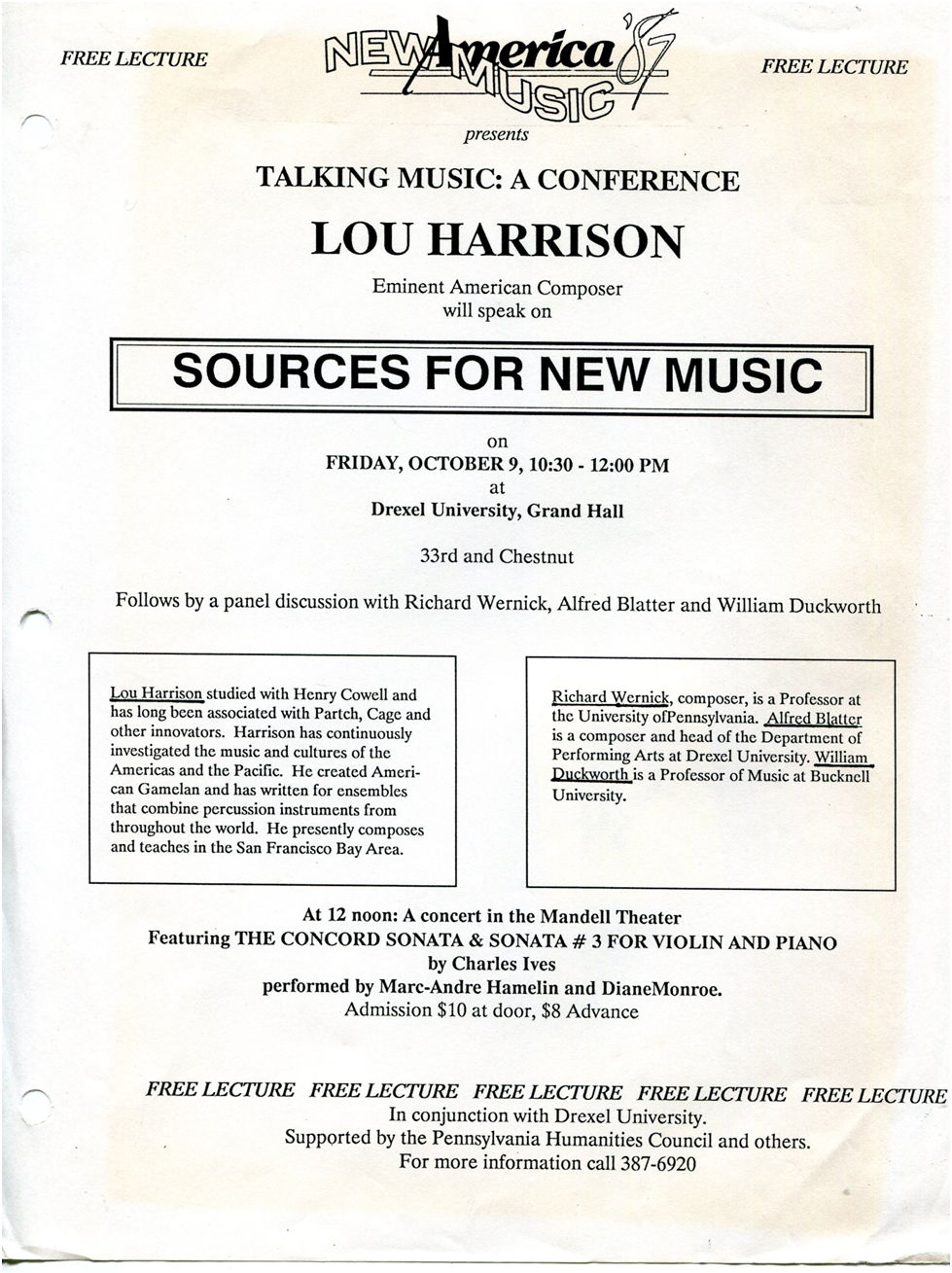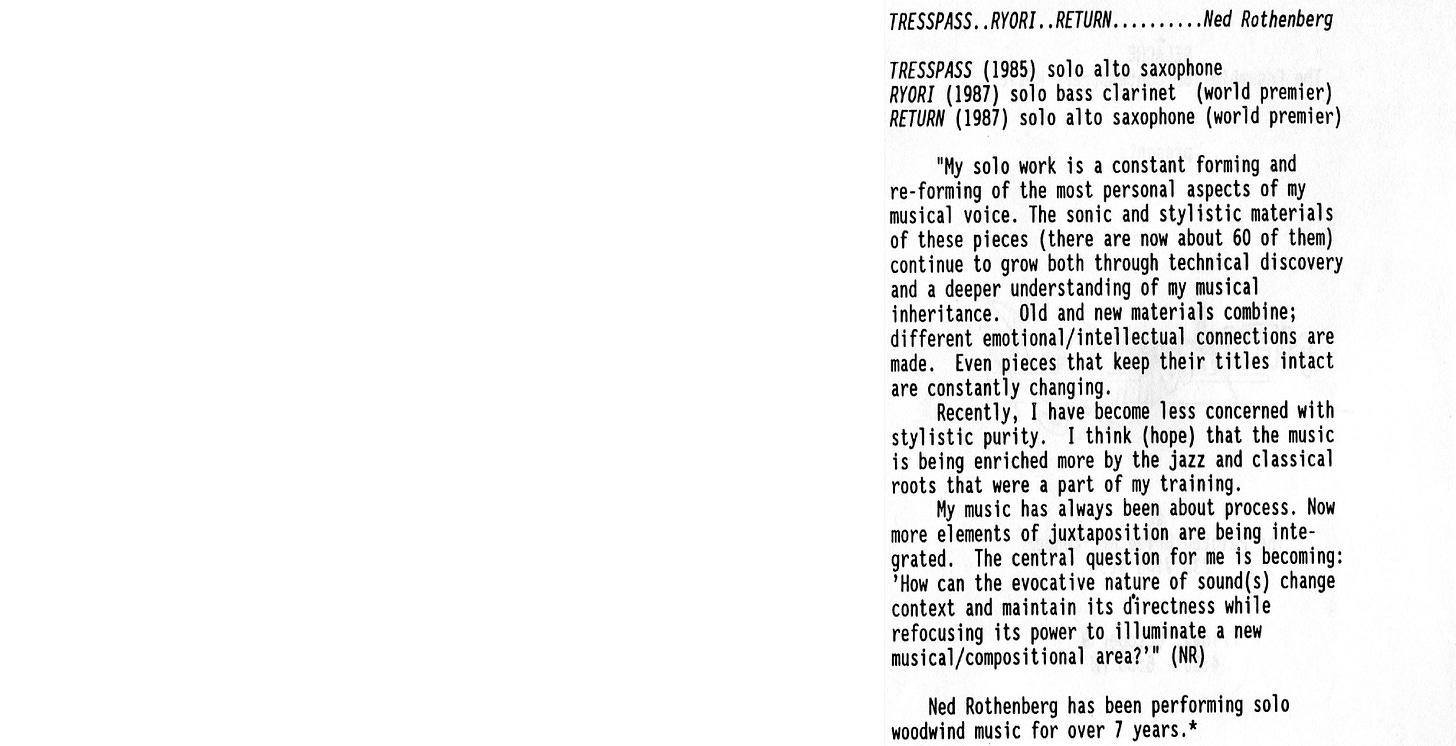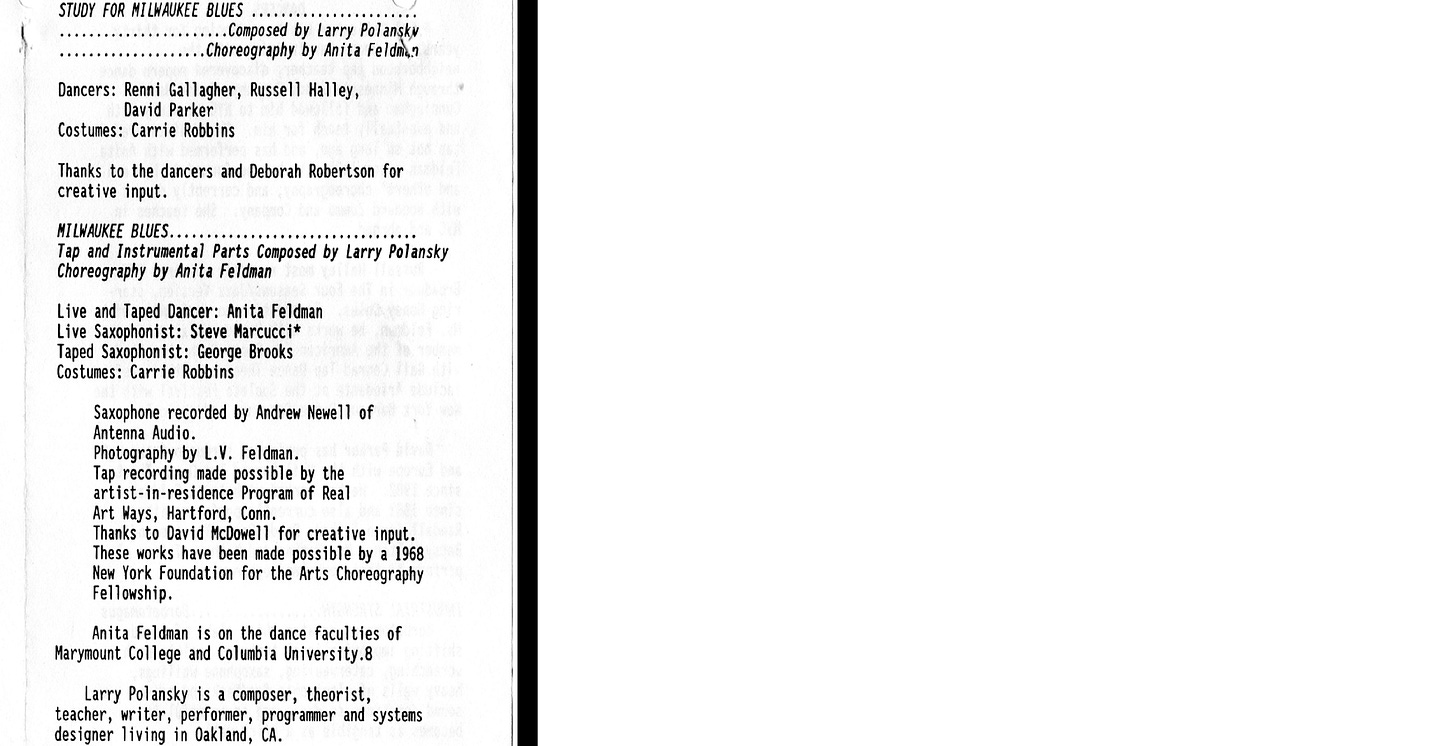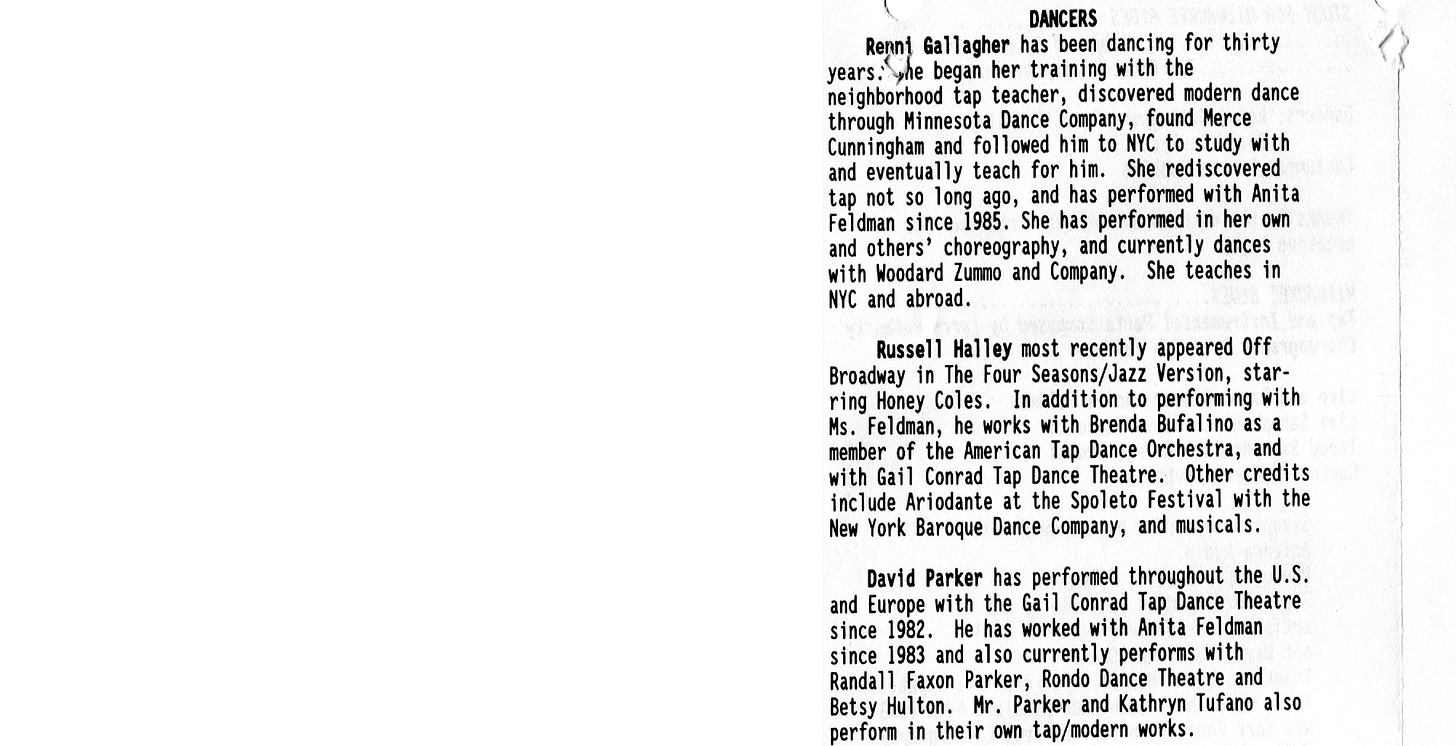October 9, 1987 NMA Philadelphia day 8
Lou Harrison, Marc-André Hamelin, Diane Monroe, Ned Rothenberg, Tom Cora, Byard Lancaster, David Eyges, Anita Feldman, Invite the Spirit, Geri Allen, two panels and... BORBETOMAGUS!
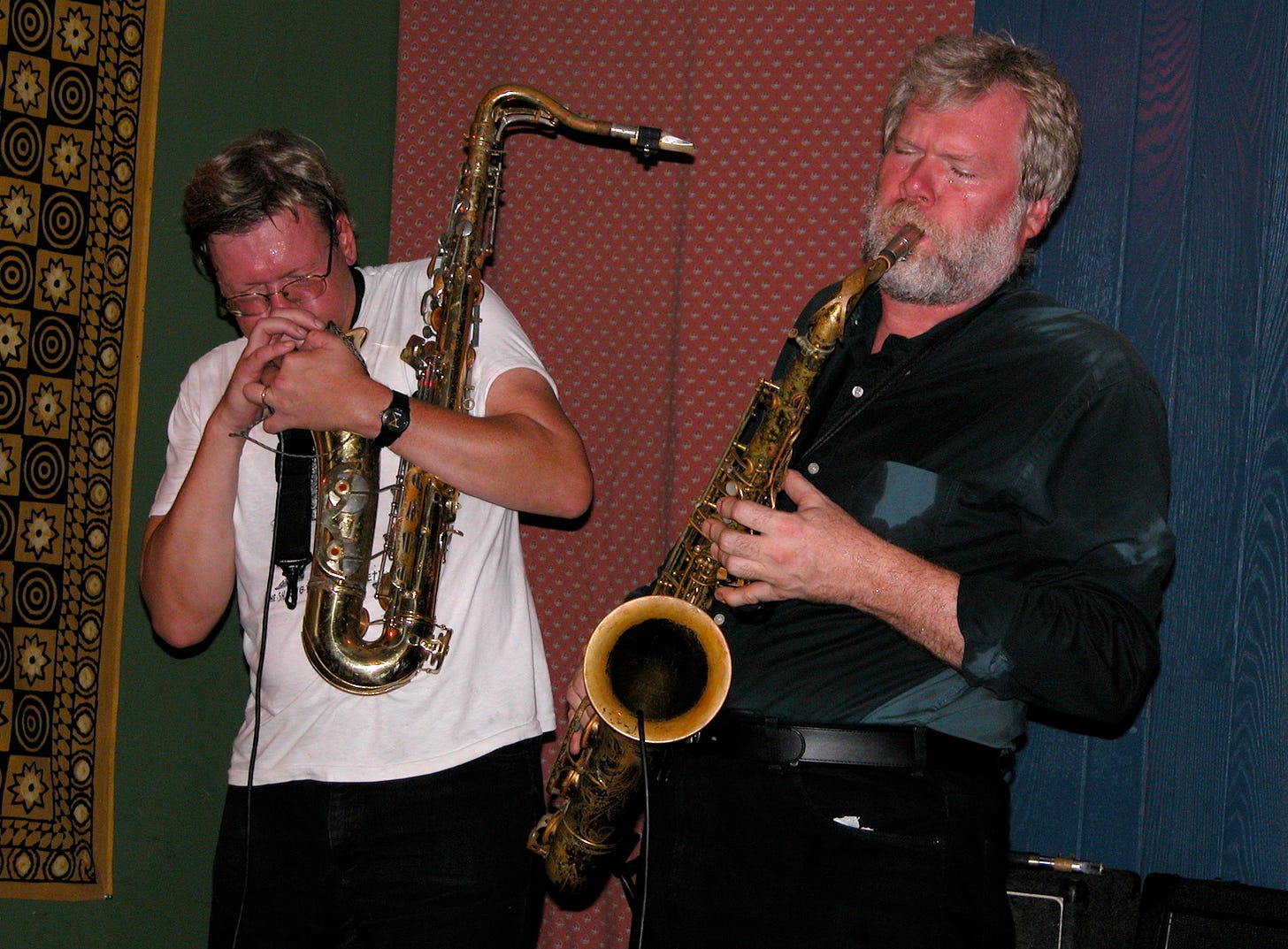
Friday October 9, 1987 New Music America Philadelphia
New Music Alliance Meetings Day 4: Report on NMA NYC 1989
Lou Harrison: “The Sources of New Music”
panel with Richard Wernick, Alfred Blatter, William Duckworth “and others”.
Marc-André Hamelin and Diane Monroe play Charles Ives
Sonata No. 3 for Violin and Piano
The Concord Sonata
Panel: Douglas Hollis, Leif Brush, Richard Posner, Annea Lockwood, Brian Ransom and Suzanne Delehanty: “Sound/Object, Environments and Participation”
Ned Rothenberg: Trespass, Ryori and Re-Turn
Tom Cora Cello solo
Byard Lancaster / David Eyges
Anita Feldman: Milwaukee Blues
Invite the Spirit (Charles Noyes, Sang-Won Park and Henry Kaiser)
Geri Allen: Solo Piano
Jim Sauter and Borbetomagus: Industrial Strength
New Music America Salsa Party
========================
Friday October 9, 1987 New Music America Philadelphia
New Music Alliance Meetings Day 4: Report on NMA NYC 1989
Part 1 This one I haven’t yet transcribed nor listened to, except for quality check; that will come later and I’ll post a note on this URL with the link
Part 2
part 3
Lou Harrison: “The Sources of New Music”
panel with Richard Wernick, Alfred Blatter, William Duckworth
♪
Marc-André Hamelin and Diane Monroe play Charles Ives
Sonata No. 3 for Violin and Piano
I did manage to save/find about seven minutes from this work’s performance
Version by Timothy Fain and Jeremy Denk
The Concord Sonata
Hamelin’s full recording.
*
Further perspective was provided by music from America's heroic, ultramodern period. … Marc-André Hamelin performed a moving, monumental Ives Concord Sonata...
- Kyle Gann, "Quiet Heroics", Village Voice, November 10, 1987
*
Another NMA highlight, then: Earlier yesterday at Mandrell Theatre, vioinist Diane Monroe and pianist Marc-André Hamelin played Ives' Third Sonata with warmth, and in its ragtime second movement, a rhythmic and tonal precision that was memorable.
- Lesley Valdes, "Festival features an energetic cello solo by Tom Cora", Philadelphia Inquirer, October 10
===================
Panel: Douglas Hollis, Leif Brush, Richard Posner, Annea Lockwood, Brian Ransom and Suzanne Delehanty: “Sound/Object, Environments and Participation”
♪
Ned Rothenberg: Trespass, Ryori and Re-Turn
*
Clarinetist Ned Rothenberg and Tom Cora (separately) did some incredible playing, but I ended up wishing they had commissioned someone to write pieces for them.
- Kyle Gann, "Quiet Heroics", Village Voice, November 10, 1987
♪
Tom Cora Solo Cello
On the glass half full, though, there is this brief excerpt of a video shot in the same state and the same year… and having been privileged to sit 10 feet away from his Philly gig, I can indeed confirm, it was this beautiful and more…
*
Margaret Leng-Tan, meet Tom Cora.
Leng-Tan, the Asian pianist whose repertoire of extended techniques proved riveting at her New Music America festival recital on Monday, has a worthy peer in Virginian Cora.
He is a cello soloist, but one suspects they could create intriguing duos, based on Cora's extraordinary virtuosity during an NMA program at the painted bride Art Center yesterday.
A beanpole of a guy, Cora's easygoing manner set people smiling before he even hooked up the cello to the amps and preamps that are also his stock in trade.
Besides playing the instrument conventionally, he attaches an amplifier to it, and then uses his feet to pedal in extra-electronic effects.
One foot can at any time record and/or play back the performance so he can improvise against it. The other foot pedal "triggers" bursts of prerecorded sound. This four-limbed effect can be wild and wooly or tremendously invigorating. It is musical.
He doesn't stop there. Like Leng Tan and other contemporary virtuosos, Cora (who is also a member of the duo Skeleton Crew) knows how to "prepare" his instrument.
At yesterday's performance, where the music ranged from monumentally propulsive to raspy, warlike or lyrical, Cora used a comb, wheels from a toy car and metal skewers on the strings or near the bridge.
Also dangling from the bridge were rubber bands with which he created wacky melodies. Whether he was playing the instrument "straight" or altered - the sense of momenum and musical line were impressive.
- Lesley Valdes, "Festival features an energetic cello solo by Tom Cora", Philadelphia Inquirer, October 10
♪
Byard Lancaster / David Eyges
The next work on the program is by Byard Lancaster, a well known musician from Philadelphia, and also a musical activist. I knew Byard Lancaster, not as a friend but a someone who was very dominant on the Philadelphia new jazz scene. The story I tell about Byard is that he and I both used to ride the Frankford-L. Byard lived in a section of the town in which he needed the L to get into Center City also for gigs.
37:39 And he’d tell this great story of when he would ride the Frankford-L, he would always hear the sound of the elevated train as it made a short turn from the elevated to the subway just before Second Street in Philadelphia. And that sound was a screeching, metallic sound that just reverberated right through you and Byard, Byard said one time that whenever he picked up is horn, he always picked thought of that sound and he tried to achieve it.
38:07 ● Well, I think to go from French tritone dominants to the sound of the Frankford-L is one large leap! (Chuckles) That’s what happens in this program.
38:22 Joseph Franklin: The piece you’re going to hear is a duo with a cellist named David Eyges – he had just begun a collaboration with Byard and I think it’s really a unique ah sound that they’ve achieved. When you listen, you hear Byard responding to the cello in a very different manner than he responded to the jazz ensembles he played with. There’s more space. There’s more, ah, color between the instruments. It’s really quite – I think really stunning what they did [...]. So, this is part four of a four part work, and this one is titled The Hill.
(the work appears in the podcast linked below)
- Joseph Franklin The Relâche Chronicles
♪
Anita Feldman: Milwaukee Blues
Two very tiny snippets of the music of their dance…
Is prerecorded tap dancing an extended musical technique? Why not, says New York dancer-choreographer Anita Feldman, who has spent the last five years collaborating with new music mavens. The second of her collaborations with California composer Larry Polansky debuted last night at the Port of History Museum, and it was a lot of fun.
Called Milwaukee Blues, it is based on a traditional train song by Charlie Poole. it is scored for live and prerecorded saxophone, a dancer (in this case Feldman) and prerecorded tap dancing. Sometimes the (live) saxophonist sings. Always the (live) dancer seems to be portraying something, although this was not exactly clear from the performance because Feldman is frequently lead-footed and not as comical as she clearly wants to be.
But the idea is clever. Tap makes an appealing percussion instrument.
- Lesley Valdes, "Festival features an energetic cello solo by Tom Cora", Philadelphia Inquirer, October 10
♪
Invite the Spirit (Charles Noyes, Sang-Won Park and Henry Kaiser)
Two minutes of Invite the Spirit
*
When a member of Philadelphia's Shamanistics group rattled a clamshell necklace on his bongos, or when Charles K. Noyes of Invite the Spirit popped bubble wrap on a snare drum, I thought it was 1969. I heard composers over 40 wonder aloud where these performers had been when they were doing the same stuff. It requires either inexperience or a short memory to call it new. If these improvisers thought they were working within Cage's "let sounds be themselves" philosophy, they missed the point. Cage's music involves a massive effort (as anyone who's sat and thrown coins to realize one of this indeterminate pieces can tell you) to bypass what the mind comes up with out of its own habits, to produce something livelier and more unexpected than is possible in spur-of-the-moment improv.
- Kyle Gann, “Quiet Heroics”, Village Voice November 10, 1987
*
As for novel percussion effects, how about this one: During Invite the Spirit's performance at the same NMA event, the trio's drummer took a sheet of that plastic stuff used in packing and began popping it. The sound wasn't effective.
Lesley Valdes, "Festival features an energetic cello solo by Tom Cora", Philadelphia Inquirer, October 10
♪
Geri Allen: Solo Piano
♪
Jim Sauter and Borbetomagus: Industrial Strength
part 1
part 2
*
But I was impressed, too, by the week's loudest and grossest work, Industrial Strength by Borbetomagus. Using two saxes, drum sets, and what sounded like a thousand loudspeakers, they created a blank, unremittingly ugly wall of sound. I fled with the rest of the rats, but I admired the clarity of their antisocial minimalism.
- Kyle Gann, “Quiet Heroics”, Village Voice November 10, 1987
*
There were times in my career as a presenter of New Music events when even I questioned my motives. One of those concerned a quartet of young musicians named Borbetomagus. Those four guys might have passed for a member of a high school chess club except, that is, when they took to the stage. There, at times, they looked like they might be posing for an X-rated promotional photo: one of the two saxophonists leaning backwards his knees bent while steadying his pose; the other saxophonist standing on a chair in front straddling him, their tenor saxophones joined at their bells appearing as one large instrument uniting the two human figures. And they are both blowing their brains out! Behind the caterwauling saxophone screeching an electric guitarist and bass guitarist are laying down thick slabs of sound, not so much as an accompaniment but as a complement to the overall loud improvisational sound texture. And was it ever loud! Deafening actually.
So loud in fact that just about everyone in the theatre cleared out, except for one or two hardy (or foolish) sould and me. Borbetomagus. I have no idea what their name means. They were, without a doubt, among the more controversial artists to perform on New Music America '87.
During the panel selection process when their tape was playing one of the panel members, Bob Wisdom, tapped to become artistic director at the Institute for Contemporary Art in London, was overly enthusiastic about the group. I remember Bob saying, "Joseph, you got to put these guys on the festival. They'll really shake things up." Another panel member, Walter Boudreau, the eccentric brilliant conductor and saxophonist from Montreal jumped up saying, "Wow. If these guys can keep up this intensity for a half hour, you have to have them. They are definitely crazy." No question about it. They were. I did. They did. Shake things up, that is.
We programmed their set to conclude the first full week of the festival's evening concerts at the Port of History Theatre. Prior to their assault to
241
the senses, the other artists on the concert were pretty, well, sedate: pianist Geri Allen, who at that time had not fully emerged on the national scene, opened the concert with an extended solo work beautifully displaying her brilliant technique and swinging style, then choreographer-tap dancer Anita Feldman with contact microphones located strategically on the dance floor to record and process the sound of her tapping feet performed a new work with music by Larry Polanski. Finally, Borbetomagus took the stage.
Even though I had heard the sound check earlier in the day I - along with everyone else in the theatre - was not prepared for Borbetomagus' intense sonic display. I cannot remember ever before hearing anything that loud on a concert stage, including Glenn Branca's guitar orchestra that had both endeared yet enraged audiences with their loud just-intoned performances. Compared to Borbetomagus, Glenn's "guitar-armies" band sounded like a string quartet! No, these guys were in their own uniquely sonic world.
Knowing they would be controversial I made certain that I - the person responsible for putting them on stage - was visible; I sat about halfway back in the center of the theatre with Laurel Wyckoff and Arthur Sabatini. As Borbetomagus' performance gained momentum and loudness, people started leaving, first a few at a time then in large numbers. By the time Borbetomagus finished their set there were about eight people left in the theatre, several ecstatic over the performance. As the sound began to ebb into silence, I remember someone yelling, "Yeah! Yeah!" The applause was barely below the threshold of sound.
- Joseph Franklin, Settling Scores
♪
New Music America Salsa Party
=============================
http://www.josephfranklin.org/?page_id=21
https://www.relache.org/podcast/episode/7aa5f05a/new-music-america-1987-philadelphia




